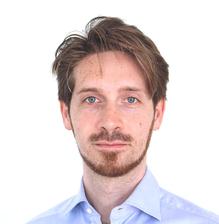Andrea Trabattoni (Image: DESY)
The European Research Council (ERC) has awarded Andrea Trabattoni, DESY scientist at the Center for Free-Electron Laser Science (CFEL), a ‘Starting Grant’ of 1.5 million euro. The ERC Starting Grants are meant as funding for early-career scientists to pursue special projects. Trabattoni is a Helmholtz junior research group leader at DESY and a junior professor in the field of ultra-fast photoelectron research at the Leibniz University Hannover (LUH). His project, called 'SoftMeter', aims to build a prototype tabletop setup for ultrafast imaging of processes occurring at the interfaces of two different materials. The grant will fund one postdoc and two Ph.D. positions, who along with Trabattoni will develop the project. It is due to begin next year and will last for a total of five years.
Trabattoni’s winning proposal focuses on the seminal concepts used in the excitation of matter using lasers. SoftMeter would use two weak electromagnetic fields – generated by combining an infrared and an ultraviolet ultrashort laser pulse – to excite electrons in molecules found at the boundary regions between two materials that are in the gas phase. The electrons, or the photons they release, would be picked up with novel spectrometers. The proposal uses the concept of self-diffraction – excited electrons literally scattering on their parent atoms – to produce data down to the picometre (one trillionth of a metre) level. Additionally, short timescales down to the attosecond (one billionth of a billionth of a second) level could be reached.
“This entire concept will be novel,” says Trabattoni. “We would use the two colours of laser to illuminate targets in a ‘noninvasive’ way.” By noninvasive, Trabattoni is referring to how experiments in so-called strong field physics work. In strong-field physics, intense laser pulses image a sample, but the intensity of the light also invasively affects the image itself. The lasers used for SoftMeter would be far less intense, thus acquiring much more accurate information from the target. This also means more complicated targets could be studied for the first time at high time resolution and at the picometre level – a method he calls soft-field spectroscopy.
“Soft-field spectroscopy would be a good complement to free-electron laser studies of complex molecules,” Trabattoni says. Studies proposed with the setup include investigations of processes at aerosol interfaces that could be relevant to catalysis and the harvesting of solar energy. The SoftMeter setup would also be extremely compact. As a table-top interferometer, the setup is planned to be approximately one metre by three metres in size, with the ability to be interfaced to a variety of experiment setups.
“We are thrilled that Andrea has been awarded this grant,” says DESY Photon Science Research Director Edgar Weckert. “His proposal to develop technique for noninvasive laser studies of interfaces between materials will help expand not only the options for scientists to explore solid-state and electronic phenomena in novel ways, but ultimately the portfolio of what CFEL at DESY can offer to the photon science community.”
(Partly from DESY News)







